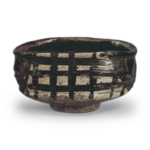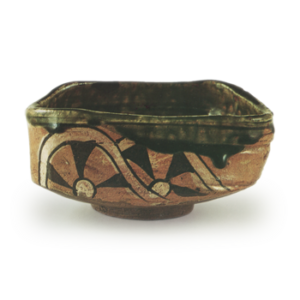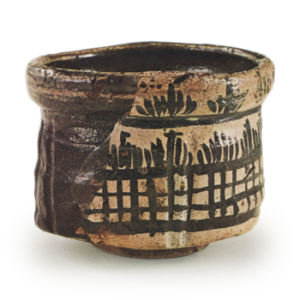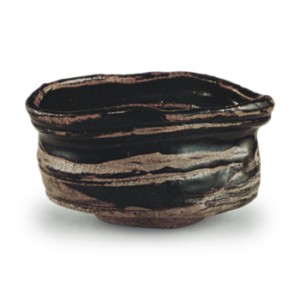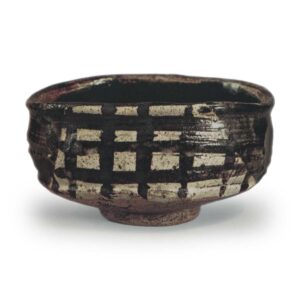
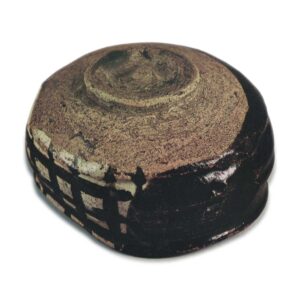
Height: 6.7-7.2cm
Diameter: 10.5-13.6cm
Outer diameter of foot ring: 5.5-5.7cm
Height of foot ring: 0.7-0.9cm
This is probably one of the best examples of a black Oribe Kutsu-gata tea bowl.
Although it is quite artificial, the overall impression is that of a subdued Oribe Kutsu, and the workmanship from the body to the rim is particularly excellent.
The shape is also very similar to Gosomaru tea bowls, and it can be said to be a typical style of Oribe-style tea bowls.
The slightly distorted circular foot is relatively small for an Oribe-style tea bowl, and the inside of the foot has been cut with a spatula-like tool, with a kabuto-kin (helmet-shaped decoration) attached to the center.
From the foot to the waist, the clay is almost completely exposed, forming a gentle curve to the waist, and although the clay is quite hard and well-fired, it has the characteristic sticky, fine clay taste of black Oribe ware. The body, which is rounded and bulging, tapers at the mouth, and the mouth is shaped with a slight upturn. The base of the body is also decorated with the deep carving unique to Oribe ware, and there are two chamfered lines from the waist to the foot ring.
There is a horizontal carving in the middle of the body on each side, and above this there is one chamfered carving on the left and two on the right, which is the same kind of intentional carving as the Gosomaru tea bowl.
The rim is curved outwards on the left and right, and the front and back are rounded, but the left side is particularly sharp, giving the whole rim a tight, powerful appearance.
The exterior front and the interior back each show a plaid pattern and a horizontal stripe pattern, which is a unique expression of this type of black Oribe ware. The inside and outside of the parts without the picture are coated with black glaze, and the picture is drawn on the remaining bare clay, and then a thin layer of feldspar-based white glaze is applied to that part.
The mouth is also white, with a white glaze applied, but the part where the black glaze is covered with a second layer of white glaze has a slightly grayish-white tinge, creating a landscape of its own.
The date of production of this type of tea bowl is thought to be slightly later than that of Setoguro and Shino, probably from the early to mid-Keicho period.
There is a note on the inside of the box lid that reads “Yafure-mado (signature)”, but it is not clear who wrote it. This tea bowl was passed down in the Konoike family of Osaka.

